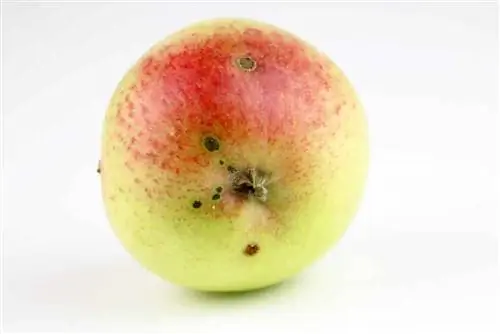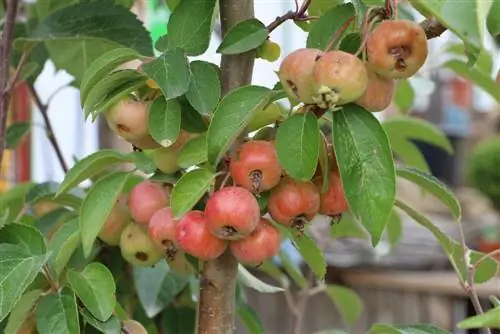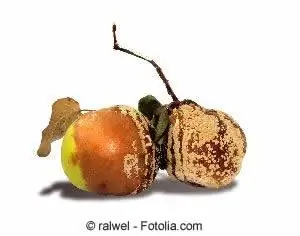- Author admin [email protected].
- Public 2023-12-17 03:39.
- Last modified 2025-01-24 12:45.
The apple web moth is just one representative of the web moths or bud moths. The butterflies that belong to the moths are mostly unknown. However, they gain the gardener's full attention when they cover an entire apple tree with a fine white web and eat it bare. Concern about the apple tree is usually unfounded, but combating spider webs may still be advisable.
Identifying the apple web moth
The moth is a moth and is rarely perceived as such by humans. The butterfly is small and inconspicuous, white in color with black dots. Individual web moth caterpillars are not noticeable either; they are also small, yellowish-brown and have the characteristic black dots. What finally catches the gardener's attention at some point are the white webs in infected trees, which can reach very large dimensions. By the time that happens, however, the webworms have already caused some damage. The female butterfly lays the eggs the year before and the larvae overwinter in a safe cocoon. They begin their feeding activity in the spring of the new year.
Damage on the apple tree
At the beginning there is almost nothing to see of the small larvae's activities, especially when it comes to larger trees. The web caterpillars initially feed within the leaves and are therefore not visible. After a short time, however, they begin to eat the leaves themselves and weave them together in ever-larger webs. Within these webs the caterpillars can be clearly seen feeding. Depending on how many larvae are in the apple tree, the entire tree can eventually be covered in fine white web threads and eaten completely bare. The tree seems dead at this point.
Combat: The right time
With all measures, it is important to apply them at the right time, otherwise they will be ineffective. In the case of the web moth, however, this period is when the infestation is barely noticeable and the gardener may not yet know that the web moth is in the tree. Once the moth larvae have ensconced themselves, combating them is difficult and works best with mechanical means.
In order to be able to intervene early, it can be advantageous to check the cut branches for apple web moth clutches when pruning fruit trees in winter. These are located on perennial shoots and are brownish colored cocoons. There are different numbers of eggs inside.
Once the infestation has been identified with certainty, several means can be used to combat it. These include:
- Plant protection products
- Cutting out the affected areas
- Parasite use
Plant protection products
Insecticides can kill the larvae in the tree. They can be used as a preventive measure in spring if apple web moth clutches have been found in the tree in winter or when the first infestation becomes visible. As soon as it is certain that the webs are large, it is no longer worth spraying insecticides because they will not reach the moth caterpillars. Another disadvantage of pesticides is that they do not have a selective effect. They also kill harmless insects. Even agents based on a bacterium that is only dangerous to butterflies kill caterpillars of other butterfly species in addition to the apple web moth larvae.
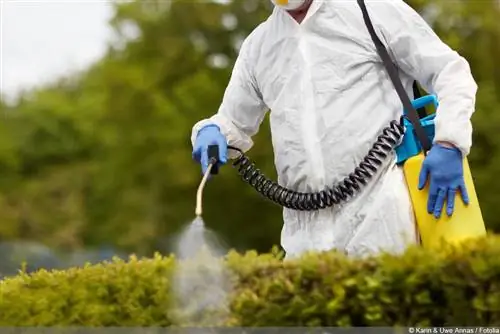
Tip:
In the garden, the use of insecticides should be avoided wherever possible. Methods that do not cause harm to other species are always preferred.
Cutting measures
The infestation can be easily controlled by pruning, but it must be taken into account that parts of the tree's crown must be sacrificed. Affected shoots and the webs are cut out with pruning shears. Pruning shears are necessary for larger infestations, even if thicker branches are involved. This measure is also worthwhile once the larvae have pupated. This can be used to remove almost all moth caterpillars and pupae from the tree.
However, it is necessary to collect all clippings from the garden and dispose of them in the garbage or a public composting facility. The ground around the tree in question should also be examined for fallen webs or pupae. With early pruning measures, other insects and butterflies are spared and at least part of the yield can be saved.
Parasite use
The use of parasites to combat insect pests is relatively new. But since it is a purely biological measure, it is becoming more and more fashionable. Almost all species of butterflies are parasitized by other insects. The infection usually occurs in the egg or in the young caterpillar. These are eaten from the inside by the parasite and can no longer develop into a finished butterfly. Reproduction is interrupted.
Parasites on butterflies:
- Parasitic wasps
- Archwasps
- Meat flies
- Caterpillar flies
Parasites can be obtained from appropriate providers. How to use them is stated in the respective instructions. Depending on the amount used, success can be very good. There is no need to be afraid of the hatching wasps, as they are solitary species that do not have much in common with the common wasp and therefore do not disturb the garden. Instead, it can be assumed that the adult parasitic wasps look for new “victims” for further reproduction and thus keep other caterpillar species in the garden in check.
When control measures do not make sense
If it cannot be overlooked that the entire tree is infected, fighting it is no longer worth it. In this case, the only thing that helps is to wait until the haunting is over and the tree sprouts again. The webs, whether with or without caterpillars and pupae, can be removed from the tree with sticks. A hard jet of water from the garden hose can also be helpful. Webs, larvae and pupae are collected and destroyed. Glue rings are placed around the tree trunk and any support posts to prevent overlooked moth caterpillars from crawling back into the tree. Otherwise, glue rings are useless to combat the apple web moth, as the moths fly and the caterpillars do not leave the tree.
Promoting beneficial insects
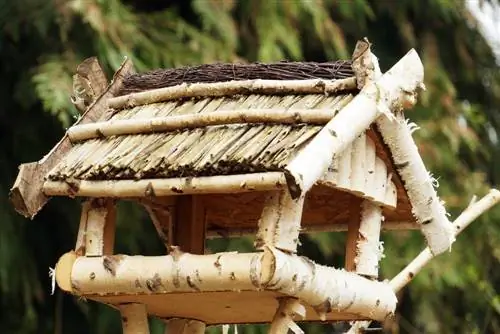
To prevent the infestation or at least prevent it from reaching large proportions, preventive measures are helpful. The most important thing is to promote biological balance in the garden so that pests and beneficial insects are balanced. Many species of songbirds are predators of butterflies and their larvae. These can be planted in the garden with the following options:
- offering nesting opportunities and nesting material
- Waterhole
- Feeding place
- natural corners in the garden with lots of hiding places
- Protection measures against predators such as cats
Regular pruning in winter is also a preventive measure. This will remove some of the clutches that may be present from the tree.
Tip:
It can be helpful to keep chickens in the orchard if you have the opportunity. Chickens eat butterfly caterpillars and their pupae and other pests that can enter the tree through the ground.


